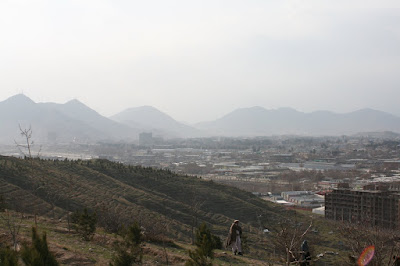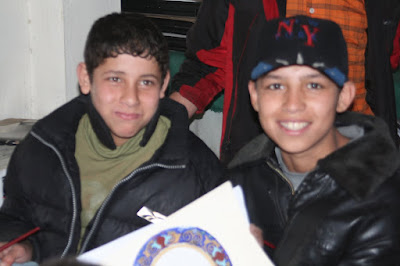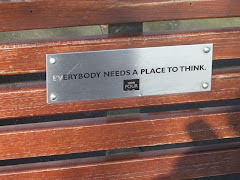


 This is a pretty typical sight in Kabul after it rains: the entire city turns into a giant mud puddle. There are extremely few paved roads in the city, just a highway or two, so it doesn't take much rain to get this result but it takes days for the roads to dry out again.
This is a pretty typical sight in Kabul after it rains: the entire city turns into a giant mud puddle. There are extremely few paved roads in the city, just a highway or two, so it doesn't take much rain to get this result but it takes days for the roads to dry out again. You've also got mountains like these looming just north of the city, which connect to the Hindu Kush.
You've also got mountains like these looming just north of the city, which connect to the Hindu Kush.



 The Kabul River--not such a pretty sight right now.
The Kabul River--not such a pretty sight right now. There's garbage strewn everywhere, all over the city. It does get picked up, but that's basically just a drop in the bucket. By the time it gets picked up in one spot, people have been dumping in five other spots. It's an endless cycle that doesn't look like it will end anytime soon, at least not until the country gets more developed.
There's garbage strewn everywhere, all over the city. It does get picked up, but that's basically just a drop in the bucket. By the time it gets picked up in one spot, people have been dumping in five other spots. It's an endless cycle that doesn't look like it will end anytime soon, at least not until the country gets more developed.

 People live in these fantastic cliff dwellings, as we called them, that climb right up the mountains and cling to the sides at impossible heights.
People live in these fantastic cliff dwellings, as we called them, that climb right up the mountains and cling to the sides at impossible heights.





 This is not a very good photo, but it shows typical Kabul traffic: horrible, chaotic, and completely insane. Driving in Kabul is basically a free-for-all. If there are any traffic laws, they aren't enforced and people drive like madmen. Anything and everything goes. Frankly, I'm somewhat amazed that we never even saw an accident the whole time we were there, much less someone get nailed. People walk right through the center of traffic, barely noticing as vehicles blast right by them. It made me nervous just to watch--I couldn't imagine doing it, but people were completely nonchalant about the whole endeavor. Just business as usual.
This is not a very good photo, but it shows typical Kabul traffic: horrible, chaotic, and completely insane. Driving in Kabul is basically a free-for-all. If there are any traffic laws, they aren't enforced and people drive like madmen. Anything and everything goes. Frankly, I'm somewhat amazed that we never even saw an accident the whole time we were there, much less someone get nailed. People walk right through the center of traffic, barely noticing as vehicles blast right by them. It made me nervous just to watch--I couldn't imagine doing it, but people were completely nonchalant about the whole endeavor. Just business as usual. A view of the city from Band-e-Qargha, up in the foothills outside Kabul.
A view of the city from Band-e-Qargha, up in the foothills outside Kabul. A bus cemetery--at least that's what Najib called it, which seemed apt.
A bus cemetery--at least that's what Najib called it, which seemed apt.

from Wikipedia
"Kabul (Persian: کابل Kābol IPA: [kɒːˈbol]; Pashto: کابل Kābul IPA: [kɑˈbul];[2] archaic Caubul), is the capital and largest city of Afghanistan, located in Kabul Province. According to a 2009 census, it has a population of 3,568,500.[3][4]
It is an economic and cultural centre, situated 5,900 ft (1,800 m) above sea level in a narrow valley, wedged between the Hindu Kush mountains along the Kabul River. The city is linked with Ghazni, Kandahar, Herat and Mazar-e Sharif via a circular highway that stretches across the country. It is also the start of the main road to Jalalabad and, further on, Peshawar, Pakistan.
Kabul's main products include munitions, cloth, furniture and beet sugar, but since 1978, a state of nearly continuous war has limited the economic productivity of the city. Economic productivity has improved since the establishment of the Islamic Republic of Afghanistan in 2001.[5]
Kabul is over 3,000 years old; many empires have long fought over the city for its strategic location along the trade routes of Southern and Central Asia. In 1504, Babur captured Kabul and used it as his headquarters until 1526, before his conquest of India. In 1776, Timur Shah Durrani made it the capital of modern Afghanistan.[6] Since the Soviet war in Afghanistan in the 1980s, the city has been a constant target of destruction by rebels or militants. It is currently in the early phases of reconstruction.[7] New construction projects are being implemented as attempts at modernizing the city."
Due to a dream I had last night about being back in Kabul, I've decided to devote an entry to the city of Kabul itself. For the most part Kabul defies description. Unless you've actually been there or somewhere like it, you can't even imagine it. Kabul is chaotic, loud, dusty, colorful, muddy, ancient, mountainous, vibrant, large, dirty, destroyed, rebuilt, full of life, bright, timeless, and so much more. There's no easy way to describe a city as full of contradictions as Kabul.
This map of the city (courtesy of Wikipedia) gives good overview of the city and provides a general idea of where neighborhoods and some sites of interest are located. A lot of these I remember seeing when I was there (from driving by them if not actually visiting them) but even more are not shown on here.
Because of security issues, we weren't able to actually walk around on the streets so instead we were driven everywhere we went and then on arrival we were hurried in from the bus inside to our destination. As a result, most of my pictures of street scenes were taken from the windows of the bus as we drove by, but some of them turned out fairly well regardless. We also did make it to a lot of the city on our way to various meetings, so I saw a lot of very different neighborhoods in the course of ten days.











































